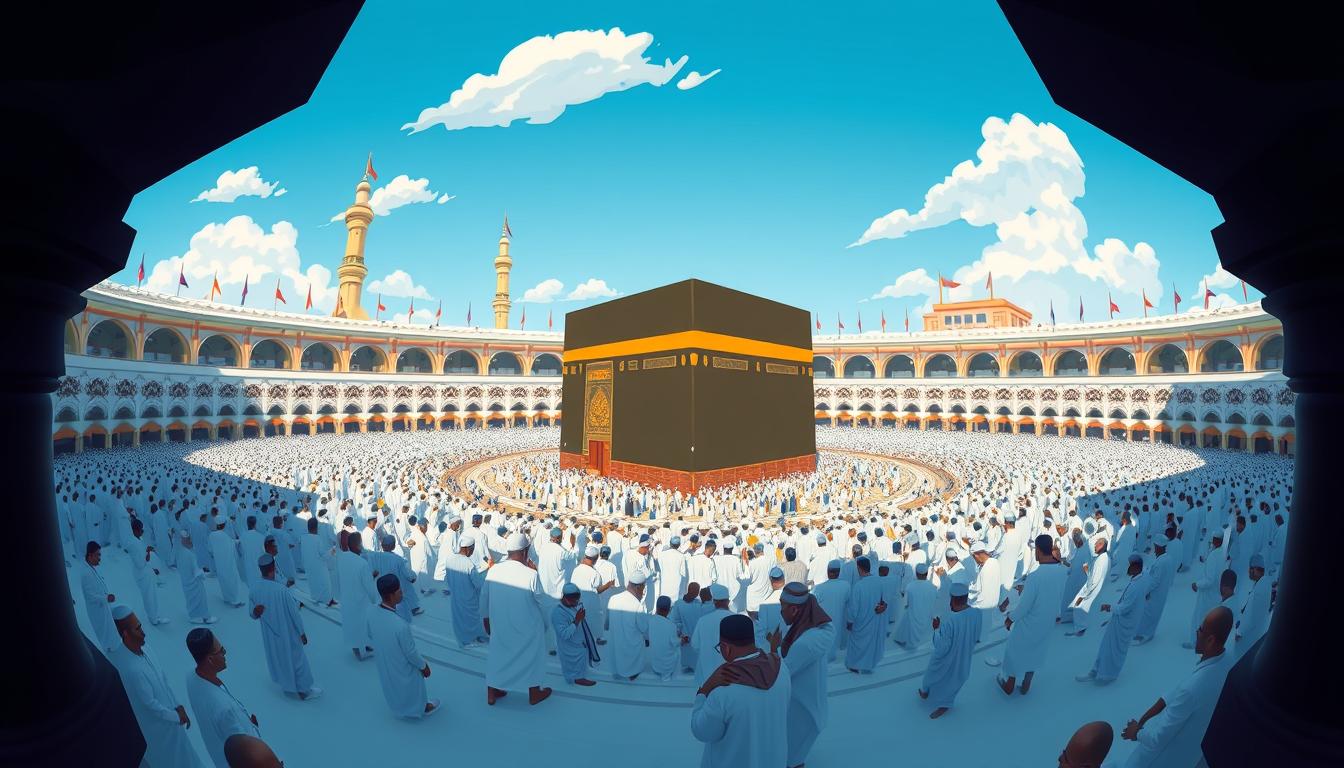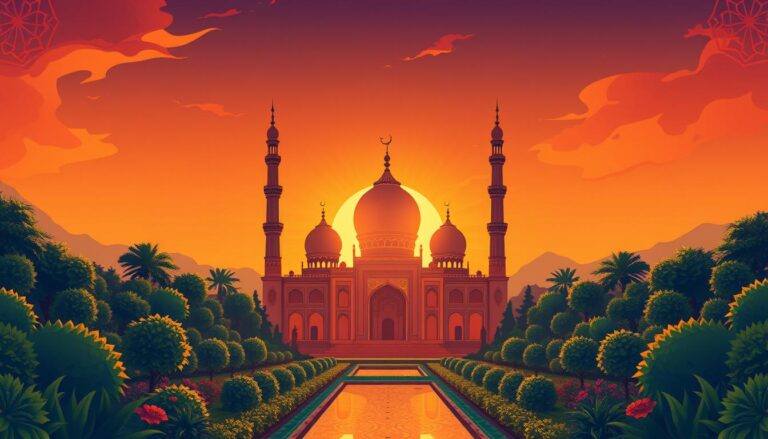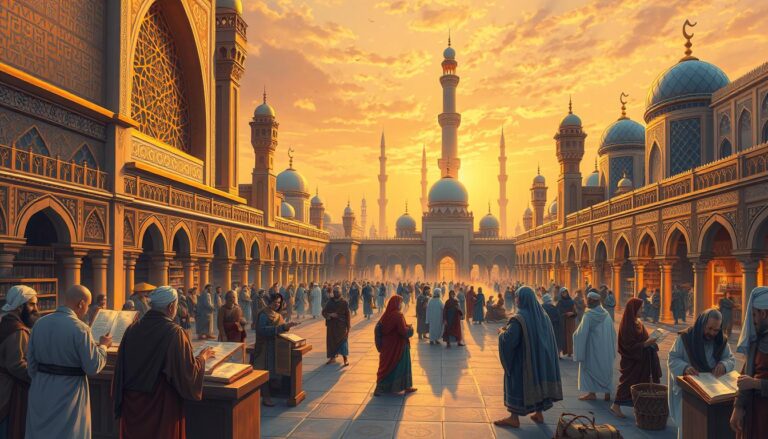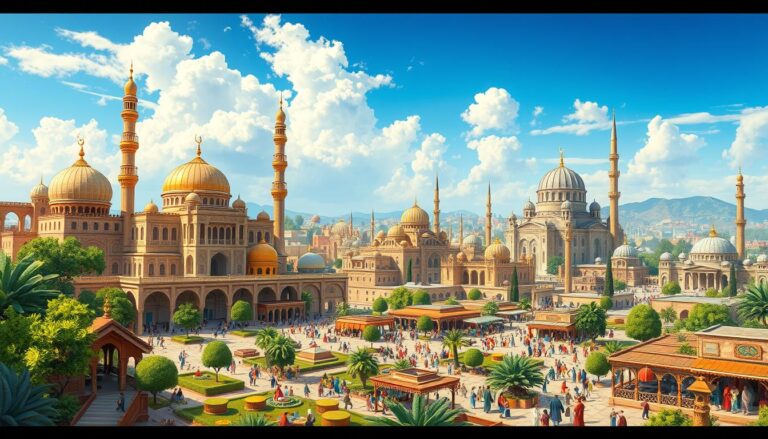How Islamic Pilgrimage Deepens Faith and Unity
Have you ever wondered why millions of Muslims go on a tough spiritual journey every year? The Hajj, an annual Islamic pilgrimage to Mecca, shows deep faith and brings people together. It’s a special time for spiritual growth and unity among believers.
Every year, over 2 million Muslims go on this five-day journey. It’s one of the biggest gatherings in the world. The Hajj is more than a physical trip; it’s a spiritual journey that follows the path of Prophet Muhammad, Abraham, and Ishmael.
Pilgrims wear simple white clothes, showing equality and unity before God. This pilgrimage is a must for Muslims who can afford it. It happens in the 12th month of the Islamic calendar, bringing believers from everywhere.
The Hajj rituals focus on sacrifice, submission, and unity. They create a sense of brotherhood that goes beyond cultural, language, and geographical differences.
Key Takeaways
- The Hajj is an annual pilgrimage drawing over 2 million Muslims worldwide
- It’s a mandatory duty for capable Muslims, occurring in the 12th Islamic month
- Pilgrims enter a state of ihram, wearing white garments symbolizing equality
- The journey traces the footsteps of Islamic prophets
- Hajj rituals emphasize sacrifice, submission, and unity among believers
Understanding the Significance of Hajj in Islam
Hajj is a key part of Islamic traditions, bringing spiritual awakening and unity. It’s a sacred trip to Mecca that’s very important for Muslims everywhere. In 2019, almost 2.5 million people went on this journey before the COVID-19 pandemic changed things.
The Five Pillars of Islam
Islam has five main pillars that guide believers. These are declaring faith, praying, giving to charity, fasting, and going on Hajj. Each pillar is important for a Muslim’s spiritual path and faith connection.
Hajj as a Mandatory Religious Duty
Hajj is more than a spiritual trip; it’s a must-do for Muslims. Every Muslim who can should go to Hajj at least once. This shows how important Hajj is in Islam.
The Spiritual Journey to Mecca
Hajj is not just about traveling; it’s a deep spiritual awakening. Pilgrims become spiritually pure in Mecca, known as “ihram.” Many see it as a chance to clean past sins and start fresh.
The pilgrimage shows equality, as people from all over join in the same rituals. This brings Muslims together, showing unity in the global community.
“The Hajj is a powerful reminder of our shared humanity and the values that unite us all.”
This journey often changes people. Some women, for example, start wearing the hijab after returning, showing their faith commitment. Through Hajj, Muslims grow closer to their traditions and each other.
The Historical Roots of Islamic Pilgrimage
The Islamic pilgrimage, or Hajj, has deep roots in ancient traditions. This sacred journey traces back to the prophets Ibrahim and Ismail, key figures in Islamic history. Their story forms the foundation of many Hajj rituals, blending faith with cultural diversity.
Islamic traditions tell of Ibrahim’s unwavering faith when commanded to sacrifice his son Ismail. This test of devotion is central to the Hajj narrative. The Kaaba, Islam’s holiest site, is believed to have been built by Ibrahim and Ismail as a house of worship.
The pilgrimage also honors Hagar, Ismail’s mother. Her search for water in the desert led to the miraculous Zamzam well, now a vital part of Hajj rituals. This story highlights the importance of perseverance in Islamic faith.
Over 2 million Muslims from around the world embark on the five-day Hajj pilgrimage each year, showcasing the global reach of this ancient tradition.
Today, Hajj continues to bring together Muslims from diverse backgrounds. Pilgrims from different cultures unite in shared rituals, fostering a sense of global community. This blend of ancient traditions and modern diversity makes Hajj a unique spiritual experience for millions of Muslims worldwide.
Preparing for the Sacred Journey: Ihram and Its Symbolism
The journey of Hajj starts with Ihram. This sacred step is a deep personal growth experience for Muslims. Ihram is more than wearing simple white clothes; it’s a heart purification process.
Entering the State of Ihram
When pilgrims reach the Miqat boundary, they enter Ihram by saying the Talbiyah. This act shows their commitment to Allah. It reminds them to seek His pleasure during the pilgrimage.
During Ihram, pilgrims must follow certain rules. They cannot cut their hair, use scented products, or have marital relations.
The Significance of White Garments
The white clothes worn during Hajj have deep meaning. They show equality and humility before Allah. They unite Muslims, showing that inner peace is more important than wealth.
Shedding Worldly Attachments
Entering Ihram means leaving worldly concerns behind. This mental shift is key for the spiritual journey. Pilgrims pray, recite the Quran, and make supplications to connect with Allah.
By letting go of material things, pilgrims open up to deep personal growth. They are ready for inner transformation.
“The simplicity of Ihram garments reminds us that before Allah, we are all equal. It’s a time to focus on our spiritual essence and let go of worldly distractions.”
The Ihram state prepares pilgrims for a transformative experience. They start their Hajj journey with pure hearts and minds focused on their spiritual goals.
The Kaaba: The Heart of Islamic Pilgrimage
The Kaaba is key to Islamic traditions and unity. It’s a cube in Mecca’s Masjid al-Haram. Muslims from all over come to it, especially during Hajj.
Muslims face the Kaaba during their daily prayers. This shows its importance in Islamic worship. It brings believers together, creating a sense of community.
“Those who participate in Jihad in Allah’s cause and perform Hajj and Umrah are guests of Allah.” – Sunan ibn Majah: 2893
During Hajj, people circle the Kaaba seven times. This ritual, called Tawaf, is mentioned in Surah Al-Hajj, 22:26. It’s about purifying the soul.
The Kaaba’s history is deep and complex. It has been rebuilt many times. Each time, it reaffirms its role in Islam.
Rituals of Hajj: A Step-by-Step Guide
The Hajj rituals are at the heart of this spiritual journey, deeply rooted in Islamic traditions. Every year, millions of Muslims go on this sacred pilgrimage. They follow meaningful steps that strengthen their faith and unity.
Tawaf: Circling the Kaaba
Tawaf starts the Hajj rituals. Pilgrims circle the Kaaba seven times counterclockwise, showing unity in worship. During each circuit, they recite prayers and supplications, diving deep into a spiritual experience.
Sa’i: The Walk Between Safa and Marwa
After Tawaf, pilgrims do Sa’i. They walk or run seven times between Safa and Marwa. It remembers Hagar’s search for water for her son Ishmael, teaching faith and perseverance.
Standing at Mount Arafat
The Day of Arafat is the Hajj’s peak. Pilgrims gather at Arafat, focusing on deep reflection and supplication. This ritual highlights equality and unity among Muslims, as they stand before God in simple white garments.
Stoning the Devil in Mina
The final major ritual is throwing pebbles at three pillars in Mina. This act symbolizes rejecting evil and renewing faith commitment. It reminds us of the daily struggle against temptation.
These Hajj rituals, done over five days, end in the joyous Eid al-Adha celebration. The journey changes pilgrims, deepening their spiritual connection and fostering global Muslim brotherhood.
How Islamic Pilgrimage Deepens Faith and Unity
The Hajj pilgrimage is a powerful force for unity and spiritual awakening among Muslims. It brings millions of believers from all over the world to Mecca. Here, they find a sense of brotherhood that goes beyond cultural and geographical differences.
During Hajj, pilgrims wear simple white garments called Ihram. This act shows equality and humility before Allah. It visually represents unity. The shared rituals like Tawaf and Sa’i strengthen the bonds between pilgrims, creating a deep sense of community.
Hajj is a challenging journey that leads to personal growth. Pilgrims face physical exhaustion, large crowds, and tough rituals. These challenges test their patience, tolerance, and faith. Many pilgrims return home with a renewed commitment to their beliefs and a deeper understanding of Islam.
“Hajj is not just a physical journey; it’s a transformative experience that purifies the soul and unites hearts.”
The collective prayers and shared rituals during Hajj create a powerful atmosphere of devotion. This environment encourages pilgrims to reflect and seek self-improvement. They seek forgiveness for past sins and start a spiritual rebirth. The lessons learned during Hajj often inspire lasting positive changes in pilgrims’ lives, fostering personal growth and a stronger faith connection.
The Day of Arafat: Climax of the Hajj Experience
The Day of Arafat is the highlight of the Hajj pilgrimage. It happens on the ninth of Dhul-Hijjah, the last month in the Islamic calendar. Millions of Muslims from all over the world gather at Arafat, near Mecca, for this sacred journey.
On this day, over 2 million pilgrims come together in prayer and reflection. They come from more than 160 countries, with about 20,000 from the U.S. This shows how Islamic traditions attract people from everywhere.
The Day of Arafat is very important in the Muslim faith. It’s a time for true repentance and asking for forgiveness. Many think that prayers on this day are more likely to be answered. This day can lead to deep personal changes and a stronger sense of peace.
“The best supplication is the supplication on the Day of Arafat.” – Prophet Muhammad
Fasting on this day is common for Muslims who are not on Hajj. It’s believed to clear sins from the past and future years. The Day of Arafat is like a spiritual reset, giving a chance to start fresh.
As the sun sets at Arafat, pilgrims leave with hope and strengthened faith. This experience often changes their spiritual journey. It deepens their connection to their faith and others.
Eid al-Adha: Commemorating Sacrifice and Devotion
Eid al-Adha is a big festival in Islamic traditions. It happens at the end of the Hajj pilgrimage. On the 10th day of Dhu al-Hijjah, Muslims all over the world come together. They show their religious unity and cultural diversity.
The Story of Prophet Ibrahim’s Sacrifice
The heart of Eid al-Adha is the story of Prophet Ibrahim’s faith. God asked him to sacrifice his son, and Ibrahim obeyed without question. This story reminds us of the strong faith in Islamic traditions.
Global Celebration of Eid al-Adha
In India, nearly 200 million Muslims celebrate Eid al-Adha. This shows how big the festival is worldwide. In Saudi Arabia, 2 million pilgrims are expected, showing the festival’s scale.
Distributing Meat to the Poor
A big part of Eid al-Adha is sacrificing animals and giving meat to others. Every year, 8.3 to 9 million animals are sacrificed. The meat is shared: one-third for family, one-third for friends, and one-third for the poor.
Eid al-Adha brings people together and helps local economies. The Hajj pilgrimage creates jobs and supports the economy. It shows the lasting impact of this sacred journey.
Challenges and Transformations: Personal Growth Through Pilgrimage
The Hajj journey is a deep experience that pushes pilgrims out of their comfort zones. Many sell valuable things, like homes, to fulfill this duty. This sacrifice starts the journey to personal growth and inner peace.
The physical challenges and crowded conditions teach patience and resilience. These qualities improve daily life long after the pilgrimage ends.
Standing at Arafat offers a chance for deep reflection, often leading to spiritual awakening. Pilgrims feel a renewed sense of purpose and humility. The unity of millions in white brings comfort and fosters understanding among different cultures.
This shared experience strengthens the global Muslim community. It builds bridges of respect and brotherhood.
The psychological benefits of Hajj are significant. Many pilgrims experience lasting inner peace. This spiritual journey can restore balance and enhance well-being.
It encourages self-assessment and goal-setting. Many align their lives more closely with religious teachings. This inspires positive changes in families and communities.
Ultimately, Hajj’s challenges lead to remarkable personal transformations. It teaches cooperation, humility, and selflessness. Pilgrims return with a deeper faith and a stronger commitment to living its values.
Source Links
- Q&A: The Hajj Pilgrimage and Its Significance in Islam
- The Spiritual Journey of Hajj: A Pilgrimage of Faith and Unity – Omanspire.om
- Q&A: The hajj pilgrimage and its significance in Islam
- The Hajj pilgrimage and why it’s significant for Muslims
- Q&A: The hajj pilgrimage and its significance in Islam
- Q&A: The hajj pilgrimage and its significance in Islam
- What is Hajj in Islam? All you need to Know – Shepherds
- What is Ihram in Hajj: Understanding the First Step of Hajj – Shepherds | Umrah Travels & Hajj Agency in Bangladesh
- A Journey of Faith and Spirituality
- What is Hajj? An In-Depth Guide to the Islamic Pilgrimage
- Embracing the Divine: An Unforgettable Journey of Faith and Self-Discovery
- Watch: The hajj pilgrimage and its significance in Islam | Loop Cayman Islands
- Comprehensive Guide to the Hajj 2025: Step-by-Step Process – Hajj Council Of North America
- How to Perform Hajj Step by Step: A Comprehensive Guide – Shepherds | Umrah Travels & Hajj Agency in Bangladesh
- The Importance of Hajj – Journey to Mecca – MOHID – Masjid Management Software
- Importance Of Hajj in Quran and Hadith-A Comprehensive Guide
- The Significance of Hajj: A Journey of Faith, Unity, and Reflection by AEM – Article – AE Magazine
- Muslim hajj pilgrims ascend Mount Arafat for day of worship
- The Significance of Hajj: A Journey of Faith, Unity, and Spiritual Renewal
- The Day of Arafat: Significance, Merits, and Recommended Actions
- Eid Al-Adha The Festival of Sacrifice and Faith| 6 Points
- Economic & Spiritual Significance of Eid al Adha & Sacrifice (Qurbani) in Islam
- Eid al-Adha: An Islamic Festival Commemorating Sacrifice, Marking the End of Annual Hajj
- Hajj: An odyssey of faith and personal growth
- Journey Within: Exploring Inner Pilgrimage in Islam and Christianity







